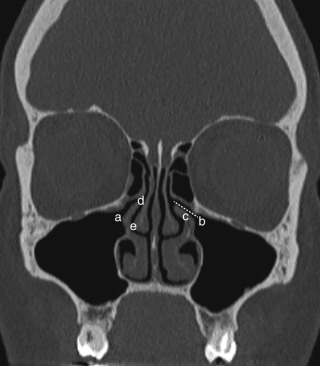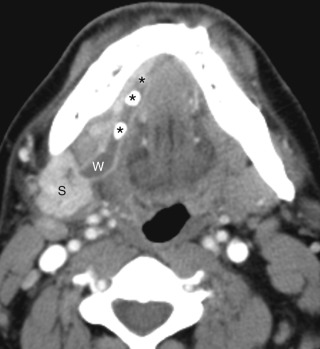Physical Address
304 North Cardinal St.
Dorchester Center, MA 02124
The ostiomeatal complex is the common drainage pathway for the paranasal sinuses. It refers to the uncinate process, a small bone, and the spaces around it through which mucus and secretions drain, including the maxillary sinus ostium, the infundibulum, the hiatus semilunaris, and the middle meatus ( Figure 44-1 ). The frontal sinuses, maxillary sinuses, and anterior ethmoid air cells drain into the middle meatus. The sphenoid sinuses and posterior ethmoid air cells drain via the sphenoethmoidal recess into the superior meatus. Only the nasolacrimal duct drains into the inferior meatus ( Table 44-1 ). The diagnosis of acute sinusitis is clinical and is typically treated medically. Imaging is reserved for patients who have chronic symptoms despite maximal medical therapy. Unenhanced computed tomography (CT) of the paranasal sinuses should not be performed during acute infection, but rather after 4 to 6 weeks of maximal medical therapy. Delineation of the anatomy of the ostiomeatal complex anatomy and the identification of any anatomic variants that narrow this common drainage pathway are important for the ear, nose, and throat surgeon (otorhinolaryngologist) to plan possible correction via endoscopic sinonasal surgery.

| DRAINAGE | STRUCTURES |
|---|---|
| Superior meatus | Sphenoid sinuses, posterior ethmoid air cells |
| Middle meatus | Frontal sinuses, anterior ethmoid air cells, and maxillary sinuses |
| Inferior meatus | Nasolacrimal duct |
The most common site involved is the maxillary sinus, followed by the ethmoid air cells. It is rare to have a malignancy arise within the frontal or sphenoid sinus. The role of the radiologist is not to make a histologic diagnosis, but rather to map the extent of disease so that the surgeon can plan his or her surgical approach. Of sinonasal malignancies, 80% are squamous cell carcinomas. The hallmark of squamous cell carcinoma is osseous destruction. Another 10% are adenocarcinomas and adenoid cystic carcinomas arising from minor salivary gland rests. Other cell types include melanoma and olfactory neuroblastomas (esthesioneuroblastoma).
The three main causes are inspissated proteinaceous secretions, mycetoma (fungus ball), and blood. Inspissated proteinaceous secretions resulting from chronic sinusitis are the most common of these entities. These dense secretions may also be seen within chronic polyps of the sinonasal cavity, and in sinonasal polyposis, there is associated expansion and bony remodeling. The increased attenuation on CT is due to high protein content. Blood within a paranasal sinus usually shows an air-fluid-hemorrhage level and is most commonly seen in the setting of acute facial fractures.
An air-fluid level in a paranasal sinus, in the absence of trauma or sinus irrigation, is a characteristic imaging finding of acute sinusitis.
The three major salivary glands are the parotid, submandibular, and sublingual glands.
The parotid gland is drained by the Stensen duct, which courses from the parotid gland and passes over the masseter muscle to pierce the buccinator muscle at the level of the second maxillary molar tooth.
The submandibular gland is drained by the Wharton duct, which drains on either side of the frenulum in the floor of the mouth ( Figure 44-2 ).

The sublingual glands consist of 12 to 18 small, paired glands located in the sublingual space in the floor of the mouth. The sublingual glands have many draining ducts, known as the ducts of Rivinus, which drain into the floor of the mouth. If there is a dominant sublingual duct opening into the Wharton duct, it is called the duct of Bartholin.
By a ratio of 4 : 1, it is more common to have calculi/stones in the submandibular gland (see Figure 44-2 ) than in the parotid gland. The submandibular gland is more prone to stone formation because of its more alkaline and viscous secretions. In addition, its draining duct is wider, has a narrower orifice, and takes an upward course. On thin-section unenhanced CT, more than 75% of these stones are radiodense. Obstruction of the duct can result in sialoadenitis (see Figure 44-2 ).
Become a Clinical Tree membership for Full access and enjoy Unlimited articles
If you are a member. Log in here